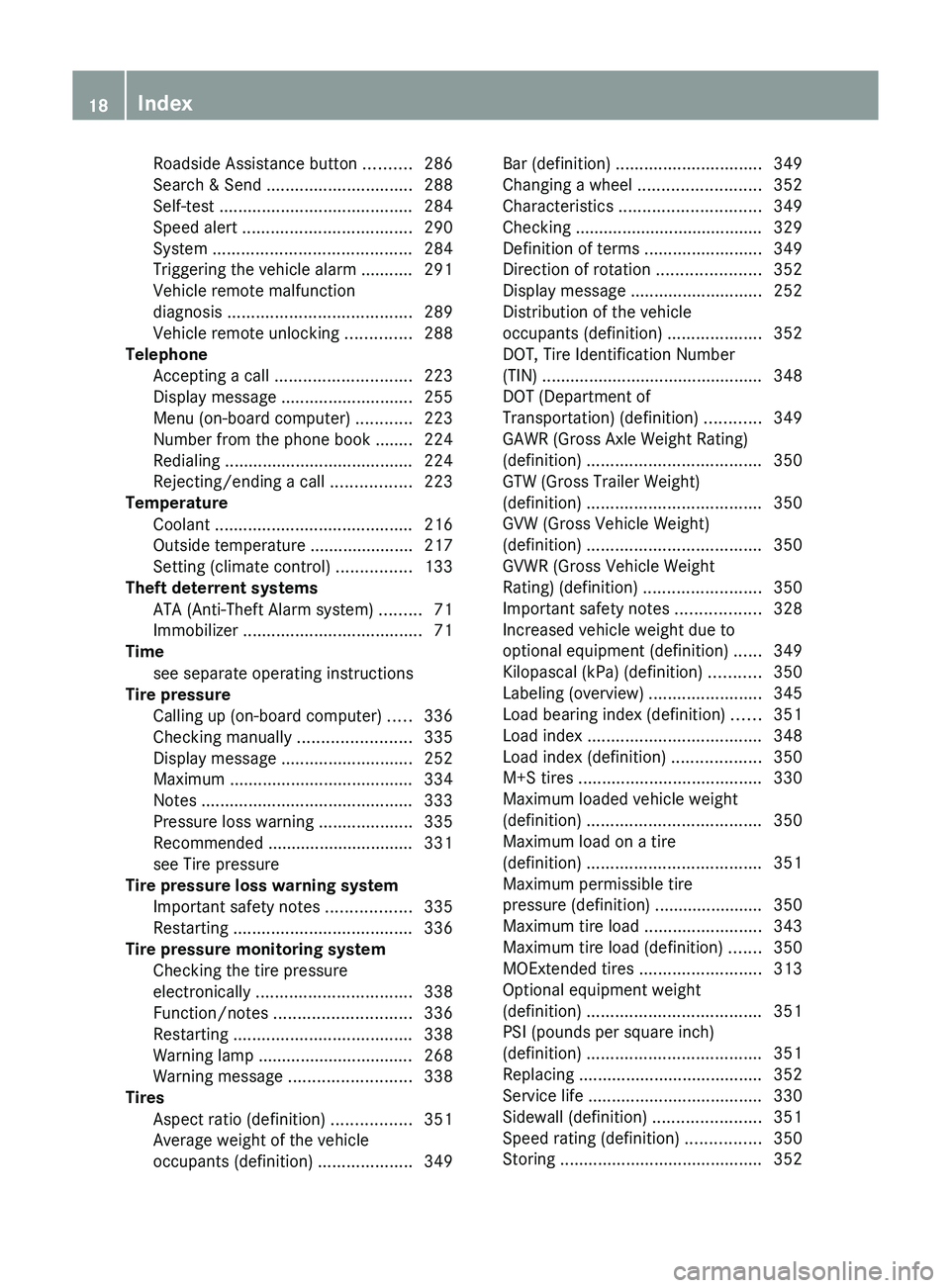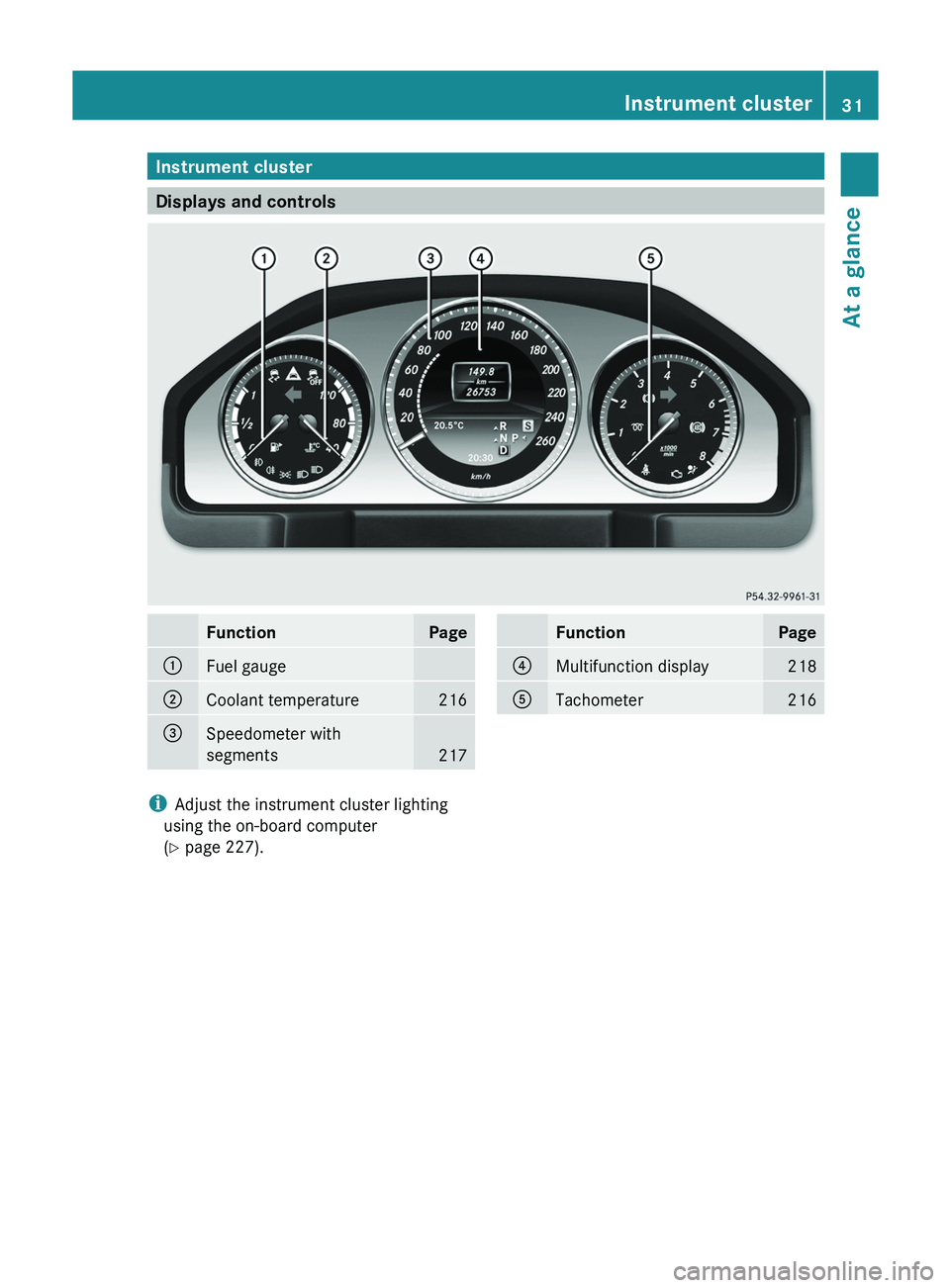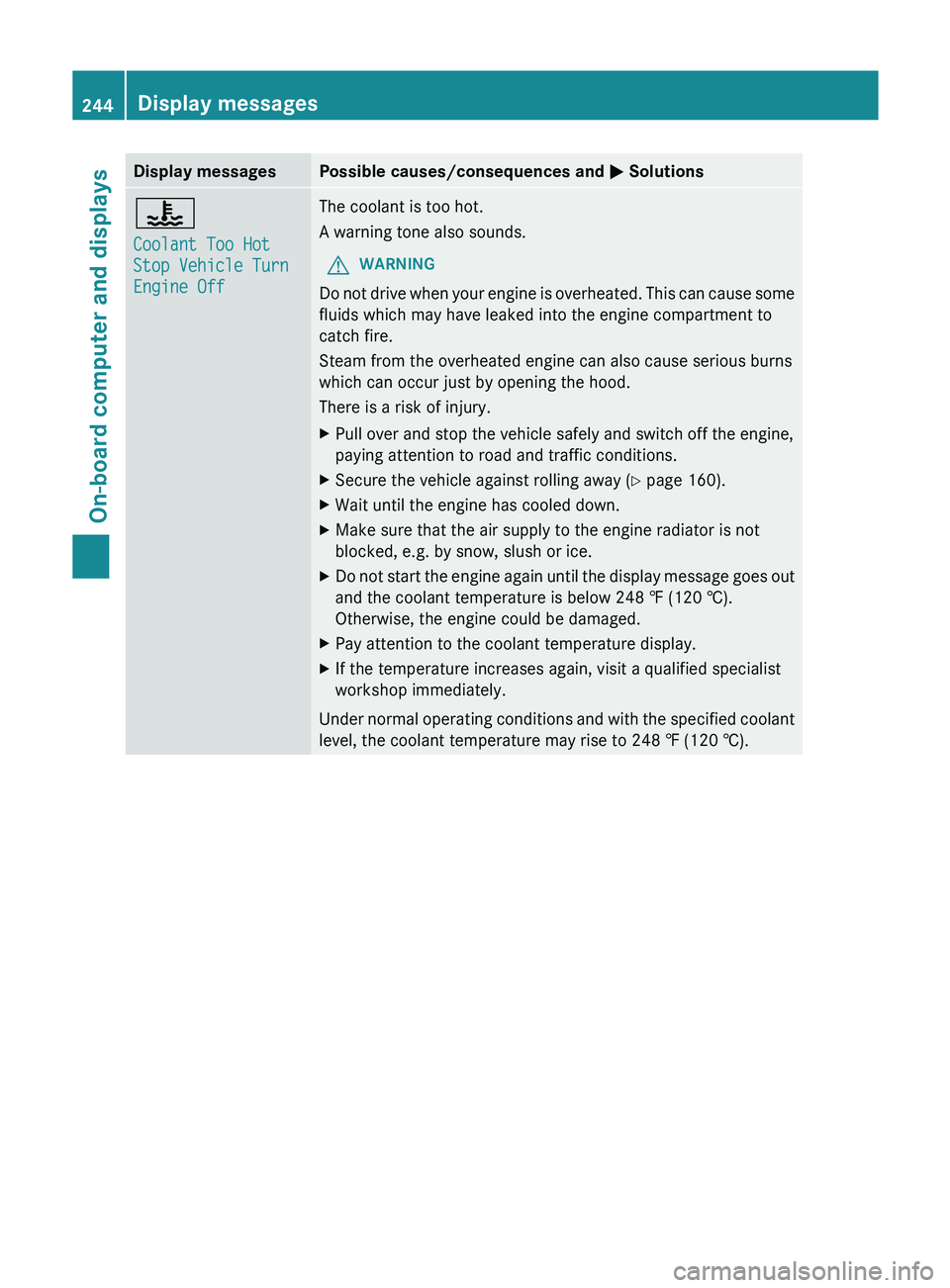2013 MERCEDES-BENZ GLK-CLASS SUV coolant temperature
[x] Cancel search: coolant temperaturePage 9 of 380

Defrosting the windows .................
135
Defrosting the windshield .............. 134
Dual-zone automatic climate
control ........................................... 127
Important safety notes .................. 126
Indicator lamp ................................ 132
Maximum cooling .......................... 135
Notes on
using automatic climate
control ................................... 128, 131
Overview of systems ...................... 126
Problems with cooling with air
dehumidification ............................ 132
Problem with the rear window
defroster ........................................ 136
Rear control panel .........................130
Refrigerant ..................................... 372
Refrigerant filling capacity .............373
Setting the air distribution .............133
Setting the airflow ......................... 134
Setting the air vents ......................137
Setting the temperature ................ 133
Switching air-recirculation mode
on/off ............................................ 136
Switching on/off ........................... 131
Switching residual heat on/off ...... 136
Switching the rear window
defroster on/off ............................ 135
Switching the ZONE function on/
off .................................................. 134
Coat hooks ......................................... 276
Cockpit Overview .......................................... 30
see Instrument cluster
Collapsible spare wheel
Inflating ......................................... 360
see Emergency spare wheel
COMAND
see separate operating instructions
Combination switch ..........................112
Compass Calibrating ..................................... 295
Calling up ....................................... 294
Setting ........................................... 294
Consumption statistics (on-board
computer) .......................................... 219
Convenience closing feature ..............88
Convenience opening feature ............87Coolant (engine)
Checking the level ......................... 302
Display message ............................ 243
Filling capacity ............................... 371
Important safety notes
..................371
Temperature gauge ........................ 216
Warning lamp ................................. 265
Cooling
see Climate control
Cornering light function
Changing bulbs .............................. 118
Display message ............................ 239
Function/notes ............................. 114
Crash-responsive emergency
lighting ............................................... 116
Cruise control Cruise control lever .......................170
Deactivating ................................... 171
Display message ............................ 251
Driving system ............................... 169
Function/notes ............................. 169
Important safety notes .................. 169
Setting a speed .............................. 170
Storing and maintaining current
speed ............................................. 170
Cup holder
Center console .............................. 278
Important safety notes .................. 278
Rear compartment ......................... 278
Customer Assistance Center (CAC) ...27
Customer Relations Department .......27 D
Dashboard see Instrument cluster
Dashboard lighting
see Instrument cluster lighting
Data
see Technical data
Daytime running lamps
Display message ............................ 242
Switching on/off (on-board
computer) ...................................... 227
Switching on/off (switch) .............. 111
Dealerships
see Qualified specialist workshop
Declarations of conformity ................. 26 Index
7
Page 20 of 380

Roadside Assistance button ..........
286
Search & Send ............................... 288
Self-test ......................................... 284
Speed alert .................................... 290
System .......................................... 284
Triggering the vehicle alarm ...........
291
Vehicle remote malfunction
diagnosis ....................................... 289
Vehicle remote unlocking .............. 288
Telephone
Accepting a call ............................. 223
Display message ............................ 255
Menu (on-board computer) ............ 223
Number from the phone book ........ 224
Redialing ........................................ 224
Rejecting/ending a call ................. 223
Temperature
Coolant .......................................... 216
Outside temperature ...................... 217
Setting (climate control) ................ 133
Theft deterrent systems
ATA (Anti-Theft Alarm system) .........71
Immobilizer ...................................... 71
Time
see separate operating instructions
Tire pressure
Calling up (on-board computer) ..... 336
Checking manually ........................335
Display message ............................ 252
Maximum ....................................... 334
Notes ............................................. 333
Pressure loss warning .................... 335
Recommended ............................... 331
see Tire pressure
Tire pressure loss warning system
Important safety notes .................. 335
Restarting ...................................... 336
Tire pressure monitoring system
Checking the tire pressure
electronically ................................. 338
Function/notes ............................. 336
Restarting ...................................... 338
Warning lamp ................................. 268
Warning message .......................... 338
Tires
Aspect ratio (definition) ................. 351
Average weight of the vehicle
occupants (definition) .................... 349Bar (definition) ...............................
349
Changing a wheel .......................... 352
Characteristics .............................. 349
Checking ........................................ 329 Definition of terms
.........................349
Direction of rotation ......................352
Display message ............................ 252
Distribution of the vehicle
occupants (definition) .................... 352
DOT, Tire Identification Number
(TIN) ............................................... 348
DOT (Department of
Transportation) (definition) ............ 349
GAWR (Gross Axle Weight Rating)
(definition) ..................................... 350
GTW (Gross Trailer Weight)
(definition) ..................................... 350
GVW (Gross Vehicle Weight)
(definition) ..................................... 350
GVWR (Gross Vehicle Weight
Rating) (definition) .........................350
Important safety notes .................. 328
Increased vehicle weight due to
optional equipment (definition) ...... 349
Kilopascal (kPa) (definition) ........... 350
Labeling (overview) ........................ 345
Load bearing index (definition) ...... 351
Load index ..................................... 348
Load index (definition) ...................350
M+S tires ....................................... 330
Maximum loaded vehicle weight
(definition) ..................................... 350
Maximum load on a tire
(definition) ..................................... 351
Maximum permissible tire
pressure (definition) ....................... 350
Maximum tire load ......................... 343
Maximum tire load (definition) .......350
MOExtended tires .......................... 313
Optional equipment weight
(definition) ..................................... 351
PSI (pounds per square inch)
(definition) ..................................... 351
Replacing ....................................... 352
Service life ..................................... 330
Sidewall (definition) .......................351
Speed rating (definition) ................ 350
Storing ........................................... 35218
Index
Page 33 of 380

Instrument cluster
Displays and controls
Function Page
0043
Fuel gauge
0044
Coolant temperature 216
0087
Speedometer with
segments
217 Function Page
0085
Multifunction display 218
0083
Tachometer 216
i
Adjust the instrument cluster lighting
using the on-board computer
(Y page 227). Instrument cluster
31At a glance
Page 150 of 380

Problem Possible causes/consequences and
0050 SolutionsThe engine is not
running smoothly and
is misfiring. There is a malfunction in the engine electronics or in a mechanical
component of the engine management system.
X
Only depress the accelerator pedal slightly.
X Have the cause rectified immediately at a qualified specialist
workshop.
Otherwise, non-combusted fuel may get into the catalytic
converter and damage it. The coolant
temperature gauge
shows a value above
248 ‡
(120 †). The coolant level is too low. The coolant is too hot and the engine
is no longer being cooled sufficiently.
X
Stop as soon as possible and allow the engine and the coolant
to cool down.
X Check the coolant level (Y page 302). Observe the warning
notes as you do so and add coolant if necessary. Automatic transmission
Important safety notes
G
WARNING
If the engine speed is above the idling speed
and you engage transmission position D or
R, the vehicle could pull
away suddenly. There
is a risk of an accident.
When engaging transmission position D or R,
always firmly depress the brake pedal and do
not simultaneously accelerate. G
WARNING
The automatic transmission switches to
neutral position N when you switch off the
engine. The vehicle may roll away. There is a
risk of an accident.
After switching off the engine, always switch
to parking position P. Prevent the parked
vehicle from rolling away by applying the
parking brake. DIRECT SELECT lever
Overview of transmission positions The DIRECT SELECT lever is on the right of the
steering column.
005D
Park position with parking lock
005E Reverse gear
005C Neutral
005B Drive
i The DIRECT SELECT lever always returns
to its original position. The current
transmission position
P, R, N
or D appears
in the transmission position display
(Y page 149) in the multifunction display. 148
Automatic transmission
Driving and parking
Page 214 of 380

when driving up or downhill, restrict the
shift range. Select shift
range 4,
3, 2, or 1.
A lower gear and lower speed reduce the
risk of engine failure.
R When driving downhill, shift to a lower gear
to utilize the engine's braking effect.
Avoid continuous brake application as this
may overheat the vehicle brakes and, if
installed, the trailer brakes.
R If the coolant temperature increases
dramatically while the air-conditioning
system is switched on, switch off the air-
conditioning system.
Coolant heat can additionally be dissipated
by opening the windows and by setting the
blower fan and the interior temperature to
maximum.
R When overtaking, pay particular attention
to the extended length of your vehicle/
trailer combination.
Due to the length of the vehicle/trailer
combination, you require additional road
space in relation to the vehicle you are
overtaking, before you can change back to
the original lane. Decoupling a trailer
G
WARNING
If you uncouple a trailer with the overrun
brake engaged, you could trap your hand
between the vehicle and the trailer drawbar.
There is a risk of injury.
Do not uncouple a trailer
if the overrun brake
is engaged.
! Do not disconnect a trailer with an
engaged overrun brake. Otherwise, your
vehicle could be damaged by the
rebounding of the overrun brake.
X Make sure that the automatic transmission
is set to position P.
X Apply the vehicle's parking brake. X
Close all doors and the tailgate.
X Apply the trailer's parking brake.
X Remove the trailer cable and decouple the
trailer. Permissible trailer loads and drawbar
loads
Weight specifications The gross trailer weight is calculated by
adding the weight of the trailer to the weight
of the load and equipment on the trailer.
Missing values were not
available
at the time
of going to print.
The maximum permissible trailer drawbar
noseweight is the maximum weight with
which the trailer drawbar can be loaded.
Missing values were not available at the time
of going to print.
Loading a trailer R
When loading the trailer, make sure that
neither the permissible gross weight
of the
trailer nor the gross vehicle weight is
exceeded. The permissible gross vehicle
weight is indicated on the identification
plate on the B-pillar on the driver's side of
the vehicle.
You can find the maximum permissible
values on the type plates of your vehicle
and the trailer. When calculating how much
weight the vehicle and trailer may carry,
pay attention to the respective lowest
values.
R The trailer drawbar load on the ball coupling
must be added to the rear axle load to avoid
exceeding the permissible gross axle
weight. The permissible gross vehicle
weight is indicated on the identification
plate on the B-pillar on the driver's side of
the vehicle.
i Mercedes-Benz recommends a trailer
load where the trailer drawbar noseweight 212
Towing a trailer
Driving and parking
Page 218 of 380

Useful information
i This Operator's Manual describes all
models and all standard and optional
equipment of your vehicle available at the
time of publication of the Operator's
Manual. Country-specific differences are
possible. Please note that your
vehicle may
not be equipped with all features
described. This also applies to safety-
related systems and functions.
i Read the information on qualified
specialist workshops: ( Y page 27).Important safety notes
G
WARNING
If you operate information systems and
communication equipment integrated in the
vehicle while driving, you will be distracted
from traffic conditions. You could also lose
control of the vehicle. There is a risk of an
accident.
Only operate the equipment when the traffic
situation permits. If you are
not sure that this
is possible, park the vehicle paying attention
to traffic conditions and operate the
equipment when the vehicle is stationary. G
WARNING
If the instrument cluster has failed or
malfunctioned, you may not recognize
function restrictions in systems relevant to
safety. The operating safety of your vehicle
may be impaired. There is a risk of an
accident.
Drive on carefully. Have the vehicle checked
at a qualified specialist workshop
immediately.
You must observe the legal requirements for
the country in which you
are currently driving
when operating the on-board computer.
The on-board computer only shows messages
or warnings from certain systems in the multifunction display. You should therefore
make sure your vehicle is operating safely at
all times. Otherwise, a vehicle that is not
operating safely may cause an accident.
For an overview, see the instrument panel
illustration (
Y page 31). Displays and operation
Coolant temperature display
G
WARNING
Opening the hood when the engine is
overheated or when there is a fire in the
engine compartment could expose you
to hot
gases or other service products. There is a
risk of injury.
Let an overheated engine cool down before
opening the hood. If there is a fire in the
engine compartment, keep the hood closed
and contact the fire department.
The coolant temperature gauge is in the
instrument cluster on the left-hand side.
Under normal operating conditions and with
the specified coolant level, the coolant
temperature may rise to 248 ‡ (120 †).
! A display message is shown if the coolant
temperature is too high.
If the coolant temperature is over
248 ‡(120 †), do not continue driving. The
engine will otherwise be damaged. Tachometer
The red band in the
tachometer indicates the
engine's overrevving range.
! Do not drive in the overrevving range, as
this could damage the engine.
The fuel supply is interrupted to protect the
engine when the red band is reached. 216
Displays and operation
On-board computer and displays
Page 245 of 380

Display messages Possible causes/consequences and
0050 SolutionsAdaptive Highbeam
Assist Inoperative Adaptive Highbeam Assist is faulty.
X
Visit a qualified specialist workshop. Adaptive Highbeam
Assist Currently
Unavailable See
Operator's Manual Adaptive Highbeam Assist is deactivated and temporarily
inoperative. Possible causes are:
R
the windshield in the camera's field of vision is dirty.
R visibility is impaired due to heavy rain, snow or fog.
X Clean the windshield.
If the system detects that the camera is fully operational again,
the Adaptive Highbeam Assist Now Available message is
displayed.
Adaptive Highbeam Assist is operational again. Engine
Display messages Possible causes/consequences and
0050 Solutions00BD
Check Coolant
Level See
Operator's Manual The coolant level is too low.
!
Avoid making long journeys with
too little coolant in the engine
cooling system. The engine will otherwise be damaged.
X Add coolant, observing the warning notes before doing so
(Y page 302).
X If coolant needs to be added more often than usual, have the
engine coolant system checked at a qualified specialist
workshop. 00AC The fan motor is faulty.
X
At coolant temperatures below 248 ‡ (120 †) drive to the
nearest qualified specialist workshop.
X Avoid subjecting the engine to heavy loads, e.g. driving in
mountainous terrain, and stop-and-go traffic. Display messages
243
On-board computer and displays Z
Page 246 of 380

Display messages Possible causes/consequences and
0050 Solutions00AC
Coolant Too Hot
Stop Vehicle Turn
Engine Off The coolant is too hot.
A warning tone also sounds.
G WARNING
Do not drive when your engine is overheated. This can cause some
fluids which may have leaked into the engine compartment to
catch fire.
Steam from the overheated engine can also cause serious burns
which can occur just by opening the hood.
There is a risk of injury.
X Pull over and stop the vehicle safely and switch off the engine,
paying attention to road and traffic conditions.
X Secure the vehicle against rolling away ( Y page 160).
X Wait until the engine has cooled down.
X Make sure that the air supply to the engine radiator is not
blocked, e.g. by snow, slush or ice.
X Do not start the engine again until the display message goes out
and the coolant temperature is below 248 ‡ (120 †).
Otherwise, the engine could be damaged.
X Pay attention to the coolant temperature display.
X If the temperature increases again, visit a qualified specialist
workshop immediately.
Under normal operating
conditions and with the specified coolant
level, the coolant temperature may rise to 248 ‡ (120 †). 244
Display messages
On-board computer and displays